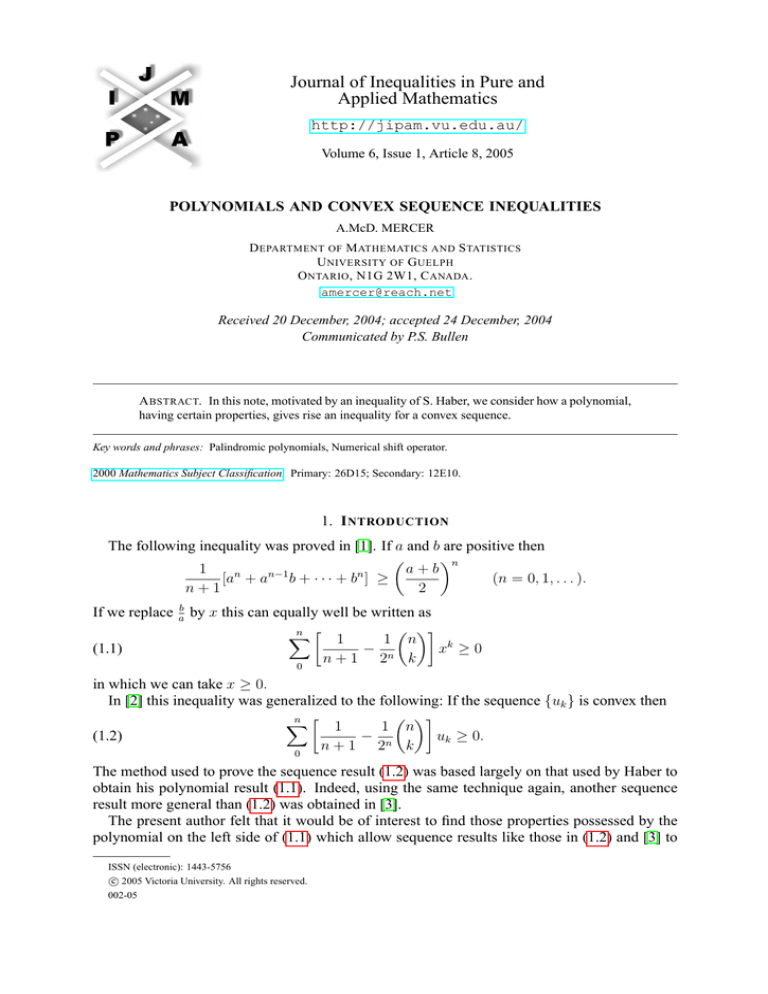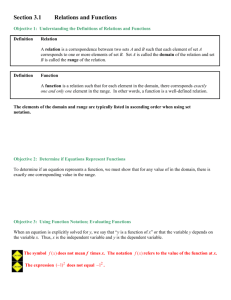
Journal of Inequalities in Pure and
Applied Mathematics
http://jipam.vu.edu.au/
Volume 6, Issue 1, Article 8, 2005
POLYNOMIALS AND CONVEX SEQUENCE INEQUALITIES
A.McD. MERCER
D EPARTMENT OF M ATHEMATICS AND S TATISTICS
U NIVERSITY OF G UELPH
O NTARIO , N1G 2W1, C ANADA .
amercer@reach.net
Received 20 December, 2004; accepted 24 December, 2004
Communicated by P.S. Bullen
A BSTRACT. In this note, motivated by an inequality of S. Haber, we consider how a polynomial,
having certain properties, gives rise an inequality for a convex sequence.
Key words and phrases: Palindromic polynomials, Numerical shift operator.
2000 Mathematics Subject Classification. Primary: 26D15; Secondary: 12E10.
1. I NTRODUCTION
The following inequality was proved in [1]. If a and b are positive then
n
a+b
1
n
n−1
n
[a + a b + · · · + b ] ≥
(n = 0, 1, . . . ).
n+1
2
If we replace
(1.1)
b
a
by x this can equally well be written as
n X
1
1 n
− n
xk ≥ 0
n
+
1
2
k
0
in which we can take x ≥ 0.
In [2] this inequality was generalized to the following: If the sequence {uk } is convex then
n X
1
1 n
(1.2)
− n
uk ≥ 0.
n
+
1
2
k
0
The method used to prove the sequence result (1.2) was based largely on that used by Haber to
obtain his polynomial result (1.1). Indeed, using the same technique again, another sequence
result more general than (1.2) was obtained in [3].
The present author felt that it would be of interest to find those properties possessed by the
polynomial on the left side of (1.1) which allow sequence results like those in (1.2) and [3] to
ISSN (electronic): 1443-5756
c 2005 Victoria University. All rights reserved.
002-05
2
A.M C D. M ERCER
be deduced directly from the polynomial itself. To this end, it is the purpose of the present note
to prove the result of the next section.
2. F ROM P OLYNOMIAL
TO
S EQUENCE I NEQUALITY
Theorem 2.1. Suppose that the polynomial
n
X
(2.1)
ak x k
0
has x = 1 as a double root and that when we write
k
X
bk =
aj
(k = 0, . . . , n − 1)
j=0
and
k
X
ck =
(k = 0, . . . , n − 2)
bj
j=0
we find that all the ck are non-negative. Then we have
(2.2)
n
X
ak u k ≥ 0
if the sequence {uk } is convex.
0
Note. The coefficients ck are simply the coefficients of
Pn
k
0 ak x
(x − 1)2
obtainable, in a simple case, by carrying out the actual division but it is convenient to have
the above formulae for both bk and ck as it is often possible to discover the properties of these
without any calculation.
Proof. Since the polynomial in (2.1) has 1 as a double root we can write
(2.3)
n
X
k
ak x = (1 − x)
0
n−1
X
bk x k
0
and
(2.4)
n−1
X
k
bk x = (1 − x)
0
n−2
X
ck xk .
0
Comparing coefficients and solving the resulting equations we get
bk =
k
X
aj
(k = 0, . . . , n − 1)
bj
(k = 0, . . . , n − 2).
j=0
and
ck =
k
X
j=0
We note, in passing, that if we extended each of the summations above to k = n then, because
the sums of all the ak and all of the bk are zero, we would have bn = 0 and cn = cn−1 = 0.
These features are apparent in the second and third examples below.
J. Inequal. Pure and Appl. Math., 6(1) Art. 8, 2005
http://jipam.vu.edu.au/
P OLYNOMIALS AND C ONVEX S EQUENCE I NEQUALITIES
3
Clearly, from (2.3) and (2.4) we have
n
X
(2.5)
k
2
ak x = (1 − x)
0
n−2
X
ck xk .
0
Now the identity (2.5) holds equally well in any commutative ring so we can replace the variable
x by E where E is the numerical shift operator which acts on any sequence {uk }nk=0 in Rn+1 as
follows:
E(uk ) = uk+1
(k = 0, 1, 2, . . . , n − 1).
So (2.5) yields the operator identity
" n−2
#
n
X
X
ak E k =
ck E k (E − 1)2 .
0
0
Given a convex sequence {uk }, we allow each side of this to operate on u0 when we get
" n−2
#
n
X
X
ak u k =
ck E k (u2 − 2u1 + u0 ).
0
That is
0
n
X
ak u k =
0
n−2
X
ck (uk+2 − 2uk+1 + uk ).
0
Since the sequence {uk } is convex and the ck are all non-negative we arrive at the result
n
X
ak u k ≥ 0
0
and this completes the proof.
3. E XAMPLES
The first example which presents itself is that discussed in the introduction. It is a simple
matter to check that x = 1 is a root of the polynomial appearing on the left in (1.1) and of its
derivative. That it is precisely a double root follows by Descartes’ rule of signs. The coefficients
in (1.1) are palindromic, taking signs (plus, minus, plus) as we proceed from left to right and
by (2.3) their sum is zero. Hence the partial sums bk take the signs (plus, minus) as we proceed
from left to right and by (2.4) their sum is also zero. From this it follows that all the ck , which
are the partial sums of the bk , are non-negative. Hence, by the theorem stated above, (1.2)
follows from the properties of the polynomial in (1.1).
Note. We emphasize here that the theorem gives the sequence inequality, not from the polynomial inequality, but from the properties of the polynomial itself. The polynomial inequality is
actually a special case of the sequence inequality. In the present example the inequality (1.1) is
a consequence of (1.2).
As a second example we give a new proof of an inequality which appears in [4] (see the
result 130 on p. 99 there). Changing the suffix notation there in an obvious way we consider
the polynomial
2n
X
ak x k ,
0
where
ak =
1
1
(k even) : ak = − (k odd).
n+1
n
J. Inequal. Pure and Appl. Math., 6(1) Art. 8, 2005
http://jipam.vu.edu.au/
4
A.M C D. M ERCER
Note. In this example k runs from 0 to 2n rather than from 0 to n. We find that
bk =
1
1
1
1
1
− +
− + ··· −
n+1 n n+1 n
n
(k + 1 terms, if k is odd)
and
1
1
1
1
1
− +
− + ··· +
(k + 1 terms, if k is even).
n+1 n n+1 n
n+1
It is now a simple matter to calculate the ck when we find that
(2n − k)(k + 2)
(2n − k − 1)(k + 1)
ck =
(k odd) :
(k even).
4n(n + 1)
4n(n + 1)
so that all the ck are non-negative. So by the theorem of the last section we deduce that
bk =
2n
X
ak u k ≥ 0
0
when the uk are convex. This is the result referred to in [4].
As a final example we consider the polynomial
2 + 3x − 7x2 − 3x3 + 5x4 .
This has 1 as a double root and the partial sums of the coefficients are 2, 5, −2, −5, 0 and the
partial sums of these are 2, 7, 5, 0, 0 which are all non-negative and so if {uk } is a convex
sequence then
2uk + 3uk+1 + 5uk+4 ≥ 7uk+2 + 3uk+3 .
Obviously this last example was contrived, starting from the result
5x4 − 3x3 − 7x2 + 3x + 2 = (x − 1)2 (5x2 + 7x + 2),
but we included it because of its purely arithmetical nature.
R EFERENCES
[1] S. HABER, An elementary inequality, Internat. J. Math. and Math. Sci., 2(3) (1979), 531–535.
[2] A.McD. MERCER, A note on a paper by S. Haber, Internat. J. Math. and Math. Sci., 6(3) (1983),
609–611.
[3] H. ALZER AND J. PEČARIĆ, On an inequality of A.M. Mercer, Rad Hrvatske akad. znan. umj.
mat., [467], 11 (1994), 27–30.
[4] G.H. HARDY, J.E. LITTLEWOOD
1973.
J. Inequal. Pure and Appl. Math., 6(1) Art. 8, 2005
AND
G. POLYA, Inequalities, Cambridge University Press,
http://jipam.vu.edu.au/







